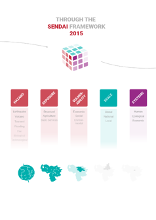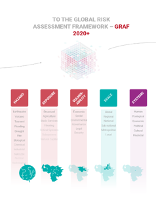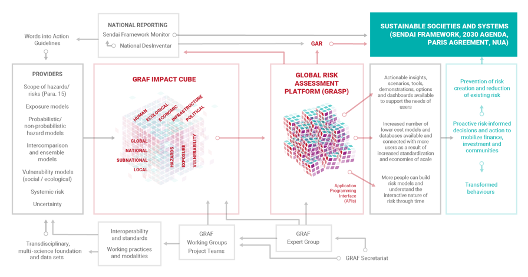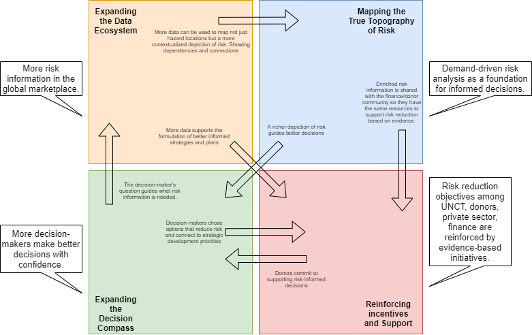Shifting the paradigm: introducing the Global Risk Assessment Framework (GRAF)
This is the eighth in a series of eight articles co-authored by Marc Gordon (@Marc4D_risk), UNDRR and Scott Williams (@Scott42195), building off the chapter on ‘Systemic Risk, the Sendai Framework and the 2030 Agenda’ included in the Global Assessment Report on Disaster Risk Reduction 2019. These articles explore the systemic nature of risk made visible by the COVID-19 global pandemic, what needs to change and how we can make the paradigm shift from managing disasters to managing risks.
Thomas Kuhn



Our global society has come to realize that systemic risks - such as the COVID-19 pandemic - can induce situations of large-scale instability and even uncontrollability. So, there is an urgent and growing need to better understand and manage uncertainties and to mobilize people, innovation and finance. The imperative to extend standard risk management frameworks or even to heed the call for a paradigm shift on how to deal with both controllable and uncontrollable risks is undeniable. This is the sort of change that the Sendai Framework exhorts.
We need a transition from managing disasters to managing risk. We need to shift from managing “conventional” hazards to engineering an improved understanding of the dynamic interactions with systemic risks. We need to explore the facilitation of a “new system of relations” that allows future theories and solutions to emerge that are “wider in scope, more accurate in prediction, and solve more problems”.
We recognize that using the same ways of understanding risk that we have always used has made us ill-equipped to manage the challenges we face. A clear example of this is the COVID-19 global emergency. We need major renovations of approaches to risk assessment and analysis. And we need this within the wider context of the Sendai Framework and the 2030 Agenda for Sustainable Development. As noted in previous articles in this series, today's methods are tuned to the largest and most historically obvious and tractable “peaks” of risks for human beings, rather than the interdependencies among them.
In recent decades, we have both created and recognized many other types of risks of the greatest consequences for humankind. Understanding the dynamic and systemic nature of risks, and the opportunities afforded by new approaches and new concepts of risk, will be the central challenge of the first half of the twenty-first century.
Antonio Guterres
In response to this challenge, the United Nations Office for Disaster Risk Reduction (UNDRR) – mandated to support the achievement of the outcome and goals of the Sendai Framework and the 2030 Agenda on Sustainable Development – was called upon by experts to establish a process to co-design and develop a Global Risk Assessment Framework (GRAF). The intention is to inform decision making and transform behaviour, specifically, with respect to complex and systemic risks, such as the COVID-19 pandemic.
The GRAF will explicitly support national and subnational governments, as well as non-State actors including private sector businesses and financial institutions [referred to in paragraph 36(c) of the Sendai Framework]. It will provide support to recognize new patterns of vulnerability and risk formation within efforts to achieve the targets of all the 2015 intergovernmental agreements; and assist in measuring progress in reducing risk. GRAF is also intended to be a crucial component of a comprehensive United Nations risk assessment and analysis framework in support of the 2030 Agenda on Sustainable Development. It will contribute to the vision of the Secretary-General of the United Nations to support decision-making for an Integrated Platform on Prevention as well as within the United Nations Resilience Framework.
Designed for complex situations, such as the COVID-19 pandemic, GRAF will inform and focus action within and across sectors and geographies by decision makers at local, national, regional and global levels on the goals and priorities for action, under uncertainty and when facing systemic risks. It will address multiple issues, including assessing systemic vulnerabilities of agricultural systems, strengthening the resilience of electricity generation and distribution systems in hurricane-prone locations or business continuity planning for public and private sector actors for basic service delivery in fast growing metropolitan areas.
The goal for GRAF is to improve the understanding and management of current and future risks, at all spatial and temporal scales. It aims to help better manage uncertainties and mobilize people, innovation and finance. It will do so by fostering transdisciplinary systems thinking and by enabling the identification of anomalies and precursor signals as a sort of systemic early warning system. It seeks to reveal the interlinkages, relationships, correlations and dependencies of multiple risks and actors across systems to build a shared understanding and enable decision makers to act. The design and development of GRAF is led by the GRAF Expert Group, GRAF Working Groups and UNDRR. GRAF is driven by a user-centric design process. It works with all stakeholders to create a framework and community of practice and to enable the understanding and sharing of risk contexts, data, information, models, metrics, risk communication modalities and decision support.
Herbert Butterfield
Through approaches such as ensemble modelling and intercomparison, GRAF over time will improve understanding of the multidimensional nature and dynamic interactions of risks, so as to prevent or adapt to discontinuities in critical systems, including human health, ecosystem functioning and economic development, and to create the potential to transform behaviours.
GRAF seeks to enable self-organization and learning focused on local processing of relational information by relevant stakeholders on the impacts and consequences of decisions, recognizing that major reductions in risk are possible through understanding and addressing patterns and contexts of vulnerability and exposure and acknowledging the underdevelopment of data on vulnerability and exposure (both social and environmental), as is being experienced in the ongoing COVID-19 pandemic. Experts have recommended focusing on vulnerability and exposure as a priority area for GRAF.

GRAF will provide options to decision-makers in any country to reduce risk by providing a clear way to understand the composition of risk, what concrete measures can be undertaken to reduce it and integrate real risk reduction within mutually-reinforcing policies, strategies, initiatives and resources, and facilitate investment in those measures.
The GRAF considers four interlocking themes essential to reducing risk:
|
Themes |
Why? |
|
We’re using too narrow a basis and spending too much time worrying about managing hazards and not enough understanding how our choices about exposure and vulnerability create risk. Countries and communities have risk information about their own contexts that is not being used. |
|
We need a way to show where and how risk accumulates to have an idea of what to do about it. |
|
We need to answer questions that stakeholders are asking about how to reduce risk to see where they can engage. We need to support the shift toward mutually-reinforcing, coordinated risk reducing action. |
|
To help decision-makers make risk-informed decisions, we need to remove barriers to using evidence. Decision-making is not just a function of information availability but also of election cycles, news cycles, project-based finance and accountability. |
The model of GRAF risk assessment begins by asking what data and risk information would enable the decision-maker to make an informed decision. Interdependencies and the contexts in which risk is created are made visible with relevant global sources of information connected to local sources to provide a more complete picture of risk in the contexts in which the decision-maker is working. That enriched depiction of risk can then form the basis for informed decisions and investments, and reinforce (and be reinforced by) existing commitments, plans and strategies to reduce risk.

GRAF will stimulate transdisciplinary systems behaviours – by governments, investors, communities and the private sector - that will support transformative action by providing insights, tools and practical demonstrations to decision makers at relevant scales. This will include the development of multi-user, open and inclusive, collaborative and shared methodologies on a timely basis. This will enable warm data research, the establishment of collaboratories and the accelerated development of collective intelligence about systemic risk. This will create a culture of risk-informed decision-making to ultimately transform behaviours and increase the resilience of societies and systems.
Realizing the systemic nature of risks, and the opportunities afforded by new approaches and new concepts of risk will be the central challenge of the first half of the twenty-first century. The GRAF community is ready to make a significant contribution to understanding and managing the COVID-19 pandemic as one of the first major events demanding new approaches to reduce the duration and extent of loss and speed up progress towards a risk-informed, sustainable and regenerative future for all people.
The authors would like to thank the many contributors to the original material - on which this series of eight (8) articles is based - that featured in the Global Assessment Report on Disaster Risk Reduction 2019
Please continue to engage with the Global Risk Assessment Framework (GRAF).